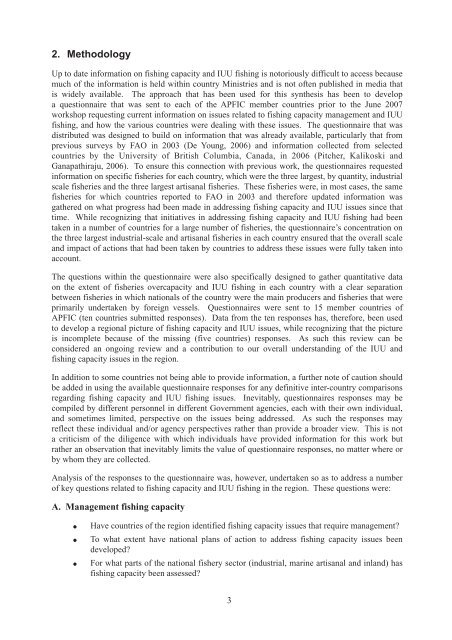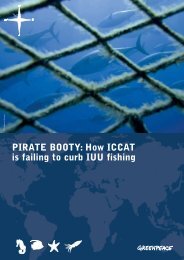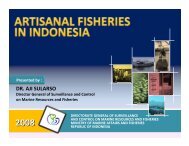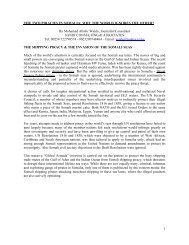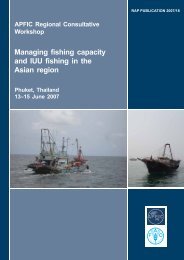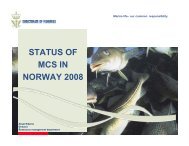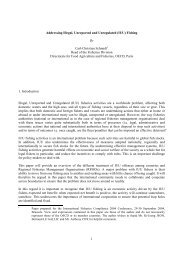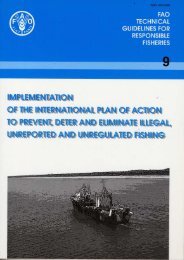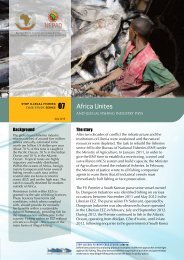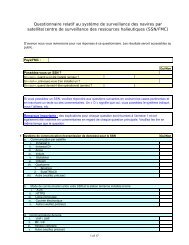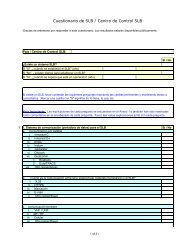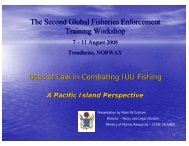Fishing capacity management and IUU fishing in Asia - FAO.org
Fishing capacity management and IUU fishing in Asia - FAO.org
Fishing capacity management and IUU fishing in Asia - FAO.org
Create successful ePaper yourself
Turn your PDF publications into a flip-book with our unique Google optimized e-Paper software.
2. MethodologyUp to date <strong>in</strong>formation on <strong>fish<strong>in</strong>g</strong> <strong>capacity</strong> <strong>and</strong> <strong>IUU</strong> <strong>fish<strong>in</strong>g</strong> is notoriously difficult to access becausemuch of the <strong>in</strong>formation is held with<strong>in</strong> country M<strong>in</strong>istries <strong>and</strong> is not often published <strong>in</strong> media thatis widely available. The approach that has been used for this synthesis has been to developa questionnaire that was sent to each of the APFIC member countries prior to the June 2007workshop request<strong>in</strong>g current <strong>in</strong>formation on issues related to <strong>fish<strong>in</strong>g</strong> <strong>capacity</strong> <strong>management</strong> <strong>and</strong> <strong>IUU</strong><strong>fish<strong>in</strong>g</strong>, <strong>and</strong> how the various countries were deal<strong>in</strong>g with these issues. The questionnaire that wasdistributed was designed to build on <strong>in</strong>formation that was already available, particularly that fromprevious surveys by <strong>FAO</strong> <strong>in</strong> 2003 (De Young, 2006) <strong>and</strong> <strong>in</strong>formation collected from selectedcountries by the University of British Columbia, Canada, <strong>in</strong> 2006 (Pitcher, Kalikoski <strong>and</strong>Ganapathiraju, 2006). To ensure this connection with previous work, the questionnaires requested<strong>in</strong>formation on specific fisheries for each country, which were the three largest, by quantity, <strong>in</strong>dustrialscale fisheries <strong>and</strong> the three largest artisanal fisheries. These fisheries were, <strong>in</strong> most cases, the samefisheries for which countries reported to <strong>FAO</strong> <strong>in</strong> 2003 <strong>and</strong> therefore updated <strong>in</strong>formation wasgathered on what progress had been made <strong>in</strong> address<strong>in</strong>g <strong>fish<strong>in</strong>g</strong> <strong>capacity</strong> <strong>and</strong> <strong>IUU</strong> issues s<strong>in</strong>ce thattime. While recogniz<strong>in</strong>g that <strong>in</strong>itiatives <strong>in</strong> address<strong>in</strong>g <strong>fish<strong>in</strong>g</strong> <strong>capacity</strong> <strong>and</strong> <strong>IUU</strong> <strong>fish<strong>in</strong>g</strong> had beentaken <strong>in</strong> a number of countries for a large number of fisheries, the questionnaire’s concentration onthe three largest <strong>in</strong>dustrial-scale <strong>and</strong> artisanal fisheries <strong>in</strong> each country ensured that the overall scale<strong>and</strong> impact of actions that had been taken by countries to address these issues were fully taken <strong>in</strong>toaccount.The questions with<strong>in</strong> the questionnaire were also specifically designed to gather quantitative dataon the extent of fisheries over<strong>capacity</strong> <strong>and</strong> <strong>IUU</strong> <strong>fish<strong>in</strong>g</strong> <strong>in</strong> each country with a clear separationbetween fisheries <strong>in</strong> which nationals of the country were the ma<strong>in</strong> producers <strong>and</strong> fisheries that wereprimarily undertaken by foreign vessels. Questionnaires were sent to 15 member countries ofAPFIC (ten countries submitted responses). Data from the ten responses has, therefore, been usedto develop a regional picture of <strong>fish<strong>in</strong>g</strong> <strong>capacity</strong> <strong>and</strong> <strong>IUU</strong> issues, while recogniz<strong>in</strong>g that the pictureis <strong>in</strong>complete because of the miss<strong>in</strong>g (five countries) responses. As such this review can beconsidered an ongo<strong>in</strong>g review <strong>and</strong> a contribution to our overall underst<strong>and</strong><strong>in</strong>g of the <strong>IUU</strong> <strong>and</strong><strong>fish<strong>in</strong>g</strong> <strong>capacity</strong> issues <strong>in</strong> the region.In addition to some countries not be<strong>in</strong>g able to provide <strong>in</strong>formation, a further note of caution shouldbe added <strong>in</strong> us<strong>in</strong>g the available questionnaire responses for any def<strong>in</strong>itive <strong>in</strong>ter-country comparisonsregard<strong>in</strong>g <strong>fish<strong>in</strong>g</strong> <strong>capacity</strong> <strong>and</strong> <strong>IUU</strong> <strong>fish<strong>in</strong>g</strong> issues. Inevitably, questionnaires responses may becompiled by different personnel <strong>in</strong> different Government agencies, each with their own <strong>in</strong>dividual,<strong>and</strong> sometimes limited, perspective on the issues be<strong>in</strong>g addressed. As such the responses mayreflect these <strong>in</strong>dividual <strong>and</strong>/or agency perspectives rather than provide a broader view. This is nota criticism of the diligence with which <strong>in</strong>dividuals have provided <strong>in</strong>formation for this work butrather an observation that <strong>in</strong>evitably limits the value of questionnaire responses, no matter where orby whom they are collected.Analysis of the responses to the questionnaire was, however, undertaken so as to address a numberof key questions related to <strong>fish<strong>in</strong>g</strong> <strong>capacity</strong> <strong>and</strong> <strong>IUU</strong> <strong>fish<strong>in</strong>g</strong> <strong>in</strong> the region. These questions were:A. Management <strong>fish<strong>in</strong>g</strong> <strong>capacity</strong>●●●Have countries of the region identified <strong>fish<strong>in</strong>g</strong> <strong>capacity</strong> issues that require <strong>management</strong>?To what extent have national plans of action to address <strong>fish<strong>in</strong>g</strong> <strong>capacity</strong> issues beendeveloped?For what parts of the national fishery sector (<strong>in</strong>dustrial, mar<strong>in</strong>e artisanal <strong>and</strong> <strong>in</strong>l<strong>and</strong>) has<strong>fish<strong>in</strong>g</strong> <strong>capacity</strong> been assessed?3


